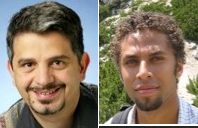Here is my new “Start-Up of the Month” chronicle, published by EPFL.
22.04.12 – Which investors trusted their money with Kandou? This startup, active in the high-tech domain, knows how to find financing.
In November 2010, EPFL celebrated its thousandth invention. I’ve extracted a passage from an article published on this occasion: “Kandou, invented by Harm Cronie and Amin Shokrollahi of EPFL’s Laboratory of Algorithms, enables processors to communicate with their peripherals (memory, printers or screens) faster while using less energy. A small revolution in the field of computer science, but which comes from mathematics!”. In March 2012, the start-up resulting from this invention announced that it had raised 10 million dollars. Some news (or rather an absence of news!) which is intriguing: this young company has very little to say about its investors. “They are private investors, not institutions or industrial concerns”, explained Harm Cronie briefly in the newspaper Le Temps. Even more surprising, this first raising of funds has already ushered in a second, which is already being organized. “I can’t say any more about this at the moment, as we are currently discussing with the investors,” he concludes.
This is not the first such venture for Amin Shokrollahi. Digital Fountain was sold to Qualcomm in 2009 – since 1998 it had raised over 50 million dollars. The start-up had support from Cisco, Sony and TI, but also trust funds such as Matrix and Granite. With Kandou, he has changed his strategy. He knows that institutional investors have constraints which force the entrepreneur to have a more mature strategy than with private investors, whereas business angels can act out of passion, and are not accountable to their own lenders.
As I mentioned in the introduction to these columns: you have to think global. For Kandou, the first partners may be called IBM or Intel. If an innovation is solid enough, clients can be located anywhere (unfortunately, however, rarely in Europe when it comes to high-tech). However, it took nearly 18 months to move forward to this acceleration phase. Kandou knew how to use the richness of the eco-system; including the EPFL spin fund, which is similar to Innogrants, venturekick or FIT. Giving birth is not instantaneous – experience shows that you need between 1 and 3 years.

Amin Shokrollahi and Harm Cronie
Moreover, Amin is not on his own: there is also Harm Cronie, co-founder and former student. The professor-student pair is one of the most conventional. It’s certainly not the most common – the partnership made up of two young entrepreneurs is probably the most-well known type (at least in the United States with Google, Yahoo, eBay, etc.). But perhaps we are forgetting that Netscape was founded by Marc Andreessen and Jim Clark, professor at Stanford and also founder of Silicon Graphics. In addition, Amin has been able to benefit from the advice of his mentor, Steve Papa. The latter founded Endeca, an American success story, which was sold to Oracle in October 2011 for over 1 billion dollars. Mentors are essential to entrepreneurs, as the latter are often isolated and must take critical decisions from the very first days of the start-up’s existence. Friendly and experienced advice is therefore very welcome. Thus, Steve Jobs could rely on Bob Noyce, the founder of Intel, during his first years as an entrepreneur.
Kandou prepared the ground to be born under a lucky star. A breakthrough technology responding to a market-driven demand, a friendly eco-system, a very talented team and investors prepared to support ambitious growth. All the necessary ingredients are there!
